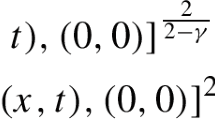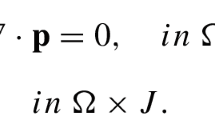Abstract
In this work one discusses a uniform observability of a semi-discrete Timoshenko beam model. We established an observability inequality to a particular class of solutions given by Fourier’s development and we prove that there exists a lack of numerical observability to the spectral problem in the setting of the spatial finite difference, i.e., the observability constant blows-up as the mesh-size h tends to zero. The semi-discrete system in finite difference avoids a numerical anomaly known as locking phenomenon on shear force and, in addition, such system raises an important problem in theoretical numerical analysis consisting in the determination of the Fourier’s solution that takes into account the parity of a sequence of the vibration modes.
Similar content being viewed by others
References
Almeida Júnior, D.S.: Conservative semi-discrete difference schemes for Timoshenko systems. J. Appl. Math. (2014)
Almeida Júnior, D. S., Ramos,A. J. A., Santos, M.L.: Observability inequality for the finite-difference semi-discretization of the \(1-d\) coupled wave equations. Adv. Comput. Math. 40 (2014)
Infante, J.A., Zuazua, E.: Boundary observability for the space semi-discretizations of the 1-D wave equation. Math. Model. Num. Anal. 33, 407–438 (1999)
Ingham, A.E.: Some trigonometrical inequalities with applications to the theory of series. Mathematische Zeitschrif 41, 367–379 (1936)
Lions, J. L.: Contrôlabilité exacte, stabilization et perturbations de systèmes distribués. Tome 1. Contrôlabilité exacte. Masson, RMA8 (1988)
Glowinski, R., Li, C.H., Lions, J.L.: A numerical approach to the exact boundary controllability of the wave equation. (I). dirichlet controls: description of the numerical methods. Jap. J. Appl. Math. 103, 1–76 (1990)
Zuazua, E.: Contrôlabilité exacte en un temps arbitrairement petit de quelques modèles de plaques. Contrôlabilité exacte, stabilization et perturbations de systèmes distribués. Tome 1. Contrôlabilité exacte, Masson, RMA8, pp. 465–491 (1988)
Stephen, W.: Taylor: A smoothing property of a hyperbolic system and boundary controllability. J. Comput. Appl. Math. 114, 23–40 (2000)
Timoshenko, S.P.: On the correction for shear of the differential equation for transverse vibrations of prismatic bars. Philos. Mag. 41, 744–746 (1921)
Tebou, L.R.T.: Sharp observability estimates for a system of two coupled nonconservative hyperbolic equations. Appl. Math. Optim. 66(2), 175–207 (2012)
Funding
A. J. A. Ramos thanks the CNPq for financial support through the projects “Asymptotic stabilization and numerical treatment for carbon nanotubes” (CNPq Grant 310729/2019-0)
Author information
Authors and Affiliations
Corresponding author
Additional information
Publisher's Note
Springer Nature remains neutral with regard to jurisdictional claims in published maps and institutional affiliations.
Rights and permissions
About this article
Cite this article
Júnior, D.S.A., Ramos, A.J.A. & Filho, E.L.M.B. An inverse inequality for Timoshenko system and some properties related to the finite-difference space semidiscretization. Rend. Circ. Mat. Palermo, II. Ser 71, 381–395 (2022). https://doi.org/10.1007/s12215-021-00598-7
Received:
Accepted:
Published:
Issue Date:
DOI: https://doi.org/10.1007/s12215-021-00598-7




